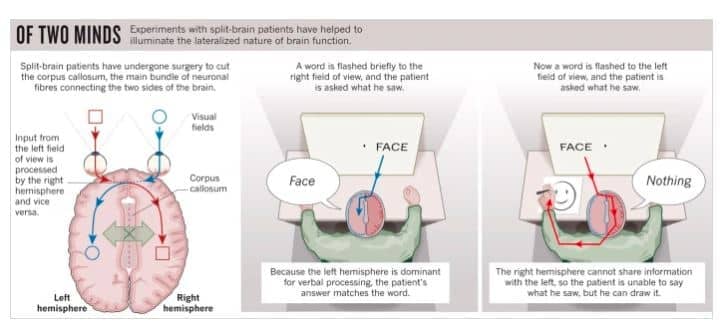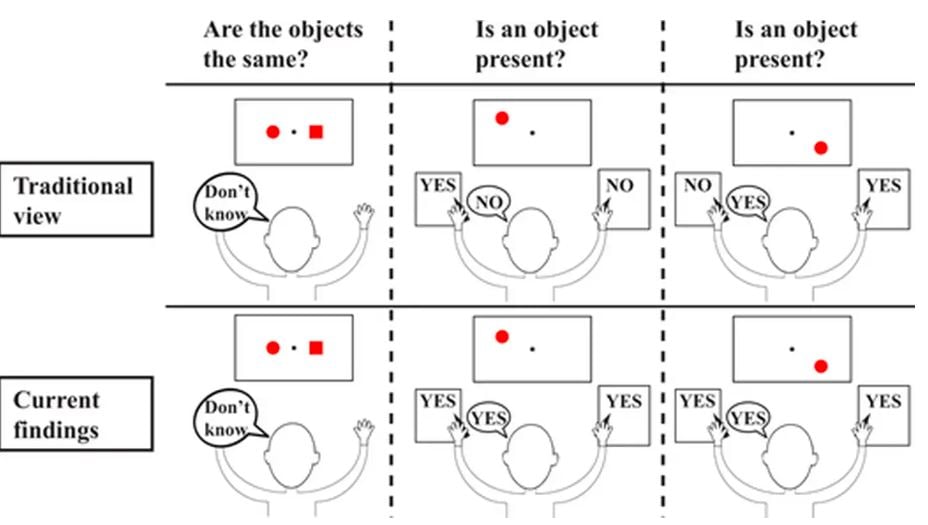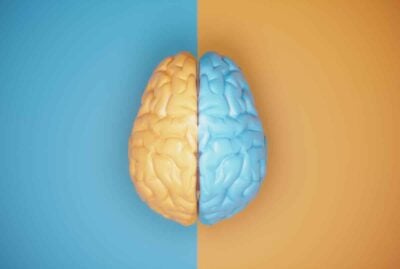Split brain experiments study the results when the corpus callosum connecting the brain’s two hemispheres is severed to some degree.
The surgical operation to produce this condition is called corpus callosotomy (not to be confused with colostomy) and is usually used as a last resort to treat otherwise intractable epilepsy.
William van Wagenen, a neurosurgeon, discovered in 1940 that by severing the corpus callosum, he could decrease the incidence of seizures in patients with epilepsy. In 1964, Roger Sperry investigated this split-brain technique further. Sperry found that the operation had little effect on general intelligence, personality, temperament, and memory.
Sperry’s split brain experiments
Unconvinced that this operation could leave a patient with such minimal effects, Sperry and his team designed techniques such as the visual half-field experiment to detect differences between split-brain and ‘whole brain’ people. An example of this would be to flash a picture to the left or to the right of the visual field. The nerve fibers from the eye cross at a point called the optic chiasm, which implies that what you see in the left visual field will go to the right side of the brain for processing and vice versa.
When split-brain patients were asked to report what they saw when a picture was flashed in the right visual field, they could easily identify and report verbally on the picture they had seen. However, they experienced problems when pictures were flashed in the left visual field. Remember that Broca’s area is responsible for speech production, and is found in the left frontal lobe. If a picture is flashed in the left visual field, it would be projected to the right hemisphere, which is not dominant for speech, and we would expect the problem of patients not being able to name what they see.
.

.
Sperry and his student, Michael Gazzaniga, gave a split-brain patient a set of four blocks with surfaces that had different colors and patterns. They asked the patient to arrange the blocks to match the patterns on the cards. They observed that the patient could complete the task easily with the left hand, but not with the right, which indicates the right hemisphere’s superior spatial ability.
Sperry received the Nobel prize in 1981. In the 1980s, Gazzaniga coined the term “cognitive neuroscience” and later became a psychology professor and researcher who helped inaugurate the study of links between the modular brain and its mental and perceptual functions.
Sperry’s split brain experiments contradicted by Pinto’s
A new research study contradicts the established view that so-called split-brain patients have a split consciousness. Instead, the researchers behind the study, led by UvA psychologist Yair Pinto, have found strong evidence that despite being characterized by little to no communication between the right and left brain hemispheres, a split brain does not cause two independent conscious perceivers in one brain. Their results were published in the journal Brain.
For their study, Pinto and his fellow researchers conducted a series of tests on two patients who had undergone a full callosotomy. In one of the tests, the patients were placed in front of a screen and shown various objects displayed in several locations. The patients were then asked to confirm whether an object appeared and to indicate its location.
In another test, they had to correctly name the object they had seen, a notorious difficulty among spit-brain patients. “Our main aim was to determine whether the patients performed better when responding to the left visual field with their left hand instead of their right hand and vice versa,” says Pinto, assistant professor of Cognitive Psychology. “This question was based on the textbook notion of two independent conscious agents: one experiencing the left visual field and controlling the left hand, and one experiencing the right visual field and controlling the right hand.”
To the researchers’ surprise, the patients were able to respond to stimuli throughout the entire visual field with all the response types: left hand, right hand, and verbally. Moreover, the patients could accurately indicate whether an object was present in the left visual field and pinpoint its location, even when they responded with the right hand or verbally. This is even though their cerebral hemispheres can hardly communicate with each other and do so at perhaps 1 bit per second, which is less than a normal conversation.
.

.
The researchers were so surprised they decided to repeat the experiments several more times with all types of control.
The results present clear evidence for the unity of consciousness in split-brain patients. Pinto explains: “The established view of split-brain patients implies that physical connections transmitting massive amounts of information are indispensable for unified consciousness, i.e., one conscious agent in one brain. Our findings, however, reveal that although the two hemispheres are completely insulated from each other, the brain as a whole can still produce only one conscious agent. This directly contradicts current orthodoxy and highlights the complexity of unified consciousness.”
Pinto plans to research more split-brain patients in the coming period to see whether his findings can be replicated. “These patients, who are rapidly decreasing in numbers, are our only way to find out what happens when large subsystems in the brain no longer communicate with each other. This phenomenon raises important questions that cannot be investigated in healthy adults because we have no technique to isolate large subsystems in healthy brains.”
.
.
Edublox offers cognitive training and live online tutoring to students with reading and learning challenges. Our students are in the United States, Canada, Australia, and elsewhere. Book a free consultation to discuss your child’s learning needs.
.




